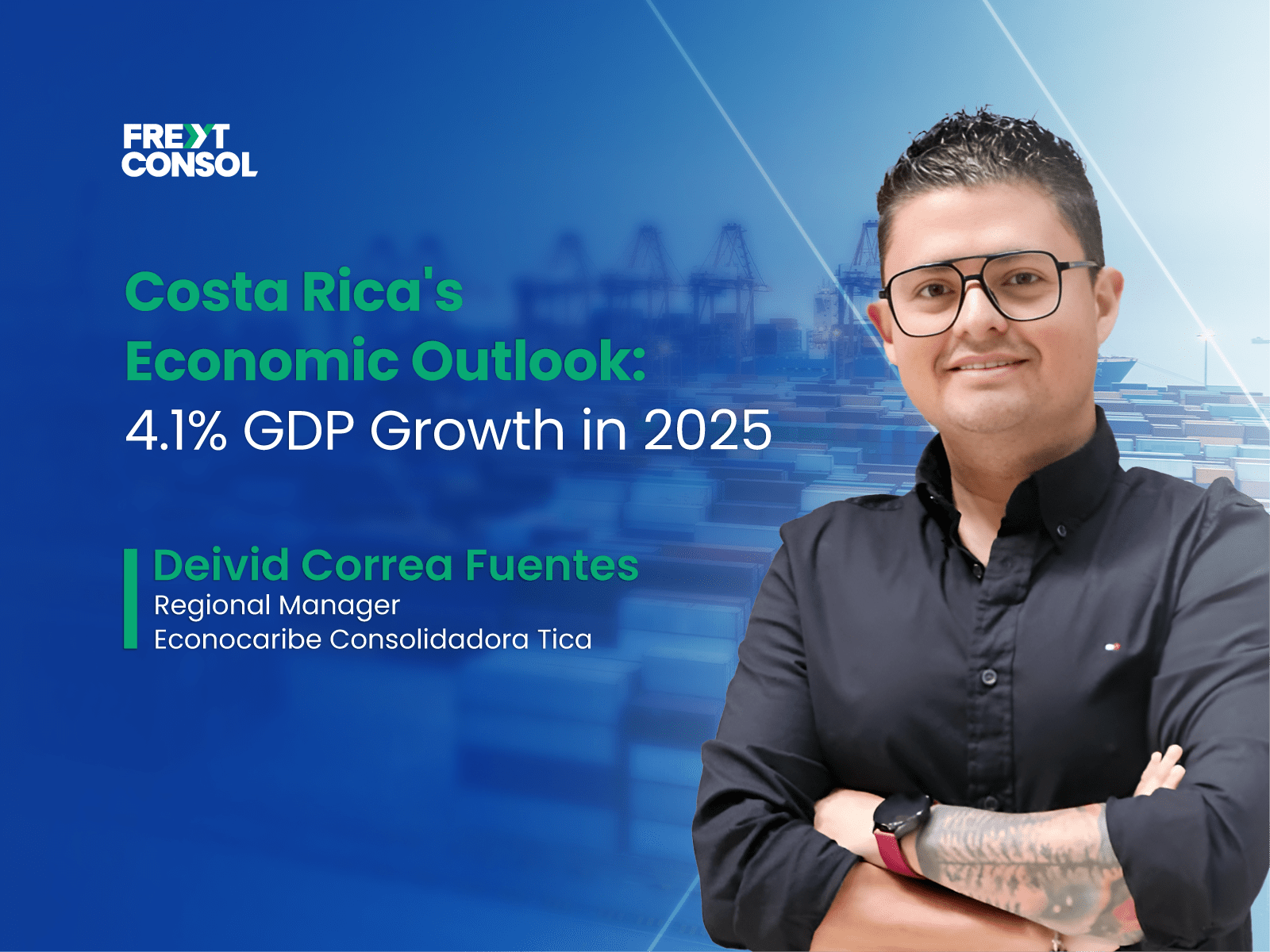By Deivid Correa Fuentes, Regional Manager of Econocaribe Consolidadora Tica

In January 2025, the Central Bank of Costa Rica updated its economic forecast, now projecting a 4.1% GDP growth for the year—an upwards adjustment from its previous estimate of 3.9%. This follows a 4.3% increase in 2024, with expectations moderating to about 4% in 2026. The improved outlook points to stronger-than-expected foreign direct investment (FDI) and continued domestic demand, notably within sectors like technology, medical devices, and tourism. For us involved in logistics, this pathway of growth highlights the pressing need for effective supply chain solutions to support trade expansion and updates in infrastructure.
Economic Drivers: FDI and Sectoral Expansion
The adjustment in Costa Rica's economic projections is fueled by record levels of FDI that hit $5 billion in 2023. This substantial investment is driven by multinational corporations focusing on sectors such as technology and medical devices. The medical devices sector alone constitutes 35% of the nation's exports and requires particularly sophisticated logistics solutions, including specialized temperature-controlled transport and streamlined customs processes. Controlled inflation, which remains within the Central Bank’s 2–4% target range, underpins the stability in domestic consumption. The tourism sector will fully recover, with visitor numbers expected to reach 3.7 million in 2025.
Costa Rica’s strategic involvement in free trade agreements with major economies such as the U.S., EU, and China strengthens its trade capabilities. These agreements lower trade barriers and simplify export guidelines, positioning the country as an advantageous hub for nearshoring activities. Consequently, logistics providers must adeptly manage the uptick in cross-border shipments while accommodating varying regulatory requirements.
Digitalization and Infrastructure in Costa Rica GDP Growth
Costa Rica's strategic location between the Americas and near the Panama Canal makes it key for diversified supply chains. DHL’s $25 million investment in San José airport expansion increases cargo handling capacities, especially for high-value goods. Digital tools like the Single Window for Foreign Trade (VUCE) platform automate and streamline customs procedures, reducing clearance times by up to 30%, according to 2024 trade statistics.
Sustainability is a core component of Costa Rica's logistics approach. The nation’s commitment to renewable energy—generating 99% of its electricity from such sources—encourages logistics firms to adopt electric vehicles and optimize delivery routes, meeting stringent global carbon emission standards. These practices particularly align with EU-bound exporters who face heightened emissions regulations.
Regional Integration and Challenges in Costa Rica GDP Growth
Costa Rica's active participation in the Central American Common Market (CACM) boosts its regional trade capabilities. However, challenges persist, especially regarding port inefficiencies. The Caldera and Moín terminals handle a significantly lower volume than Panama’s Colón port, necessitating reliance on transshipment. Although the quality of Costa Rica's roadways is generally superior to some of its regional counterparts, upgrades are still needed to support increasing freight volumes.
There's also a considerable labor shortage in areas like customs brokerage and data analytics, adding strain to operations. Implementing targeted training programs alongside increased automation could alleviate these shortages, ensuring that the workforce is equipped to meet the evolving demands of the industry.
Strategic Adaptation in Costa Rica GDP Growth
The logistics industry's growth in Costa Rica hinges on comprehensive modernization efforts. Accelerating updates to port facilities and expanding the highway infrastructure through public-private partnerships is crucial. Such capital investments would align resources with the projected growth in trade. An additional focus on digital transparency could be achieved through the adoption of blockchain technology for shipment tracking, minimizing errors, and enhancing trust across the supply chain.
Sustainability in the logistics sector is not only an environmental responsibility but also a growing financial necessity. Clients increasingly choose logistics partners who demonstrate measurable reductions in carbon emissions, making green practices vital for long-term strategic planning.
Balancing Growth with Efficiency in Costa Rica GDP Growth
Costa Rica’s revised 4.1% economic growth forecast highlights the country's resilience in the face of global economic fluctuations. For logistics companies, the main challenge is overcoming infrastructure bottlenecks and labor shortages while leveraging digital innovations and sustainability initiatives. Costa Rica's stable governance and educated workforce provide a solid base, but competitiveness requires targeted investments in ports, technology, and cross-border collaborations.
Efficient action today will dictate whether Costa Rica can truly fulfill its role as a regional logistics powerhouse. Precision in execution can yield substantial rewards as Costa Rica stands at the crossroads of turning potential into reality within the logistics industry. With the right strategic initiatives, the country could very well be positioned as a leader in sustainable and competitive logistics operations throughout Latin America.
Future Prospects and Strategic Initiatives
Looking ahead, Costa Rica's logistics sector must focus on several strategic initiatives to maintain and enhance its growth trajectory. First, the country should prioritize the development of smart logistics hubs that integrate advanced technologies such as IoT (Internet of Things) and AI (Artificial Intelligence) to optimize supply chain operations. These hubs can provide real-time data analytics, improving decision-making and operational efficiency.
Second, fostering public-private partnerships (PPPs) will be essential in mobilizing the necessary capital for large-scale infrastructure projects. These partnerships can bridge the funding gap and ensure timely completion of critical projects like port expansions and highway upgrades. Leveraging public and private sector expertise and resources will accelerate Costa Rica's infrastructure development and enhance logistics capabilities.
Third, enhancing workforce skills through targeted training programs and educational initiatives will be crucial. As the logistics industry digitalizes, demand grows for professionals in data analytics, cybersecurity, and supply chain management. Investing in education and training will help Costa Rica build a skilled workforce to meet evolving logistics demands.
Costa Rica's Path to Logistics Excellence
Costa Rica's projected 4.1% GDP growth in 2025 underscores the country's economic resilience and potential for continued expansion. For the logistics industry, this growth presents both opportunities and challenges. By addressing infrastructure bottlenecks, embracing digital innovations, and prioritizing sustainability, Costa Rica can position itself as a regional leader in logistics.
The country's strategic location, robust trade agreements, and commitment to renewable energy provide a strong foundation for future growth. However, realizing this potential will require concerted efforts from both the public and private sectors. Through strategic investments, workforce development, and technological advancements, Costa Rica can achieve logistics excellence and drive sustainable economic growth.
Efficient action today will dictate whether Costa Rica can truly fulfill its role as a regional logistics powerhouse. The right strategic initiatives can position the country as a leader in sustainable and competitive logistics operations throughout Latin America.

Freyt Consol Blog Contributor
Freyt Consol is a global network for LCL consolidators and NVOCCs dedicated to excellence and long-term growth. We create an environment where members thrive by collaborating with trusted partners and accessing essential resources.




